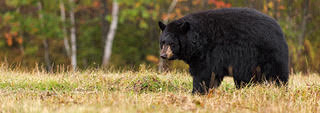Got Bait? Go Fish!
By Glen Wunderlich
Outdoor Columnist
Professional Outdoor Media Association
In light of the Michigan DNR’s recent mandate to ban all forms of baiting for deer in the Lower Peninsula, I am posting some words I wrote on the subject a few years ago.
About 25 years ago, while deer hunting along the St. Helen trail in the northern Lower Peninsula, I came across a bait pile and my immediate reaction had me thinking some poacher was at work. As a matter of fact, I really thought baiting was illegal. I then located a gut pile mere yards from the bait. Success? Maybe.
Notice that I said I was hunting. Without consulting Mr. Webster, I always thought hunting had more to do with seeking out the deer, sneaking around, and hiding somewhere after figuring out where deer might show up. And, that’s how I hunted, as did everyone else I ever knew.
As society’s need for instant gratification has grown, so has the issue of baiting. On one hand we have those pursuing deer and seemingly taking advantage of legal baiting laws, albeit much restricted today; on the other hand, we have non-baiting hunters and non-hunters raising questions of ethics, and concerns relative to horrifying herd disorders.
Since the inception of devastating diseases in Michigan and in our bordering Wisconsin, scientific studies have indicated hunters may be their own worst enemies from not only an ethical standpoint, but also from one of physiology. Unregulated baiting causes deer to concentrate in small areas for prolonged periods of time. Whereas, in more natural settings, they constantly move about as they graze. Where once we could legally dump a truckload of apples, corn, or whatever, as of last season, we were restricted to putting out no more than 2 gallons of bait per hunting site – and, those 2 gallons had to be spread in a minimum 10 foot by 10 foot area. Bait piles, as we knew them, have become illegal in Michigan, and based on scientific research, it makes sense to me apart from other personal considerations.
Let’s see how ol’ man Webster defines the word “hunt” in the form of a verb: 1) to go out to kill or catch (game) for food or sport, 2) to search eagerly or carefully for; try to find. Accordingly, whether one chooses to use bait or not, one can call himself a hunter. To me, however, the question comes down to why one hunts. Even though my approach to hunting parallels the second definition above, taking game is a fitting reward for preparation, effort, and application of skills. Wanton harvesting can also ruin a season of hunting in a sense. Let me explain.
It was October 1, 1996, opening day of archery season. In the evening session, strapped 21 feet above ground to a white oak tree, along a natural bait-less travel route, I let an arrow fly at a 7-point buck 30 yards straight ahead. He appeared to “jump the string”, or in other words, to duck under the path of the arrow. Convincing myself of a clean miss, I stayed put hoping for another opportunity before darkness descended. Within a half hour, 4 does congregated 10 yards in front of my stand creating natural decoys for what I believed to be the missed buck returning to my neighborhood. He presented the perfect quartering-away angle at 25 yards and I sent another arrow to the target. I anxiously waited until dark so my pals could finish their stints and we all went tracking together.
The trail lead to a 6-point, which had expired mere yards from a second buck – the 7-point I had “missed”. Although there was reason for celebration, there was reason for regret shortly thereafter. The perfect double-lung kills ended my 90-day plus buck hunting season as quickly as it began. Success? I guess it depends on which version of Mr. Webster’s hunt description seems most fitting to you.
I grew quite a bit as a hunter that day. Although I didn’t purposely take 2 bucks that day, I had cause to reflect on what the reality of my error meant to my hunting time afield. I relish the pursuit of deer in archery season, firearms season and ever so much in the muzzleloading season.
If I were to hunt in accordance with Webster’s #1 definition, I am sure I could whack ‘em and stack ‘em and get on with some other mundane aspect of life. However, 1996 taught me an enriching lesson culminating in a hunting style that affords me the opportunity to behold the solemnity of nature. A rewarding harvest ends it.
Got bait? Go fish.
I have focused on hunting deer over bait and have expressed my rationale for using alternative methods to hunt that are more in line with my particular style. Limited baiting for deer is still legal in Michigan, if the bait is spread out. However, bait piles – the practice of dumping bushels or even truckloads of feed – appears to be forever forbidden. To the Department of Natural Resources (DNR), the question of baiting is not ethical; rather, the practice of baiting relates to the health and well being of our herd. Like it or not, the question of ethics among the population is a significant weapon used against hunters – by hunters and non-hunters alike.
A week ago, I explained that I viewed a bait pile with a jaundiced eye when I first saw it afield some 25 years ago. In a survey of randomly dialed households conducted by the DNR, the question of ethical judgment was a very important reason for opposition to baiting. When respondents who oppose all forms of hunting were dropped from the analysis, 53 percent said baiting was unacceptable, and 9 percent were undecided. Some hunters and even more non-hunters believe baiting deer is too easy and “unfair” to the deer. Based on all information I have reviewed, I would not claim that baiting necessarily increases one’s chances of success; however, non-hunter perceptions of “unsporting” behaviors help to fuel the fairness issue. We can debate whether there is an advantage – unfair or otherwise – all we want, but I don’t believe the controversy will be resolved in the minds of people that do not hunt. So what? We need to understand that non-hunters are able to influence the establishment of game laws affecting hunters. Therefore, perception can evolve into hunters’ reality.
If we are to assume that hunters using bait tend to focus more on results than process, can we safely assume they have some type of advantage? Based on Michigan DNR Wildlife Division Issue Review Paper 5, which is a compilation of scientific studies relative to deer baiting issues in Michigan published February 26, 1999, under the title “Effect on Movement Patterns”, (A) behavioral change in deer frequently attributed to deer baiting is increased nocturnal activity (Charles 1993). Use of baited sites seemed to become more nocturnal as the hunts progressed, possibly reflecting increased wariness of deer due to continuous hunting pressure. This may suggest that human disturbance rather than the influence of bait may affect the nocturnal and diurnal behavior of deer. A Mississippi study reported that, as the number of hunters at baits sites increased, the daylight activity of the bucks at the sites decreased. That study noted that bucks used the bait stations during only 10 percent of the legal shooting hours. A Michigan DNR study concluded that disturbance affected deer activity more so than the use of bait (Wegner 1993).
These studies seem to indicate, that if hunters obey the 2-gallon bait limit, they must make plenty of trips afield, because 2 gallons can disappear quickly. As deer figure out the routine, the success rate drops accordingly.
Lazy hunters- and those that I believe help to depict hunters negatively in the eyes of the population – may violate the 2-gallon limit and illegally dump large piles to minimize trips to the woods. Of course, there is another legal option: the use of mechanical timed feeders. By law, they are limited to the same 2-gallons per day, but can spread the feed without human interference. This option would seem to make sense to those that bait on private land only, however.
Any type of baiting employed certainly doesn’t teach hunting skills. With baiting having become more widespread, woodsmanship appears to be going the way of the phone booth. In this age of fax machines, satellite TV, and picture phones, the use of bait to attract and kill deer is understandable, but that doesn’t make it acceptable to a good percentage of people.
It is my contention that short-term success is heavily outweighed by the negative aspects of baiting – be they perceived or otherwise. As hunting ground continues to vanish and city slickers inhabit bean-field lots developed from family farms, hunters may be wise to consider alternatives. For now, the hunters’ money talks, but those that remain complacent can expect more restrictions as a result of the vocal opposition’s tactics. I am certainly not naïve enough to think for a minute that all hunters will have come to the same conclusion as I have relative to baiting. However, if you’d like some viable options, follow along.
Whenever we hunters are pitted against one another in conceptual causes, the opposition, which can be other hunters, non-hunters, and animal extremists, has an advantage. If we become too obsessed with the killing of deer by whatever means, we may rationalize ourselves away from a more far-reaching, long-term goal: A viable hunting heritage.
When a hunter explains his particular hunting prowess to anyone, the story gets around. When he boasts how he took a shot from such a distance that would have made the Guinness Book of World Records, only to finish by explaining how he lost his wounded prize, the story gets around. He can even surmise how he “knows” he killed that buck, but that doesn’t count as one for the sportsmen, because his goal wasn’t to feed the coyotes. These distressing results fuel the opposition, which eats it up, dwells on it, adds a generalized spin to it, and distributes its message to the population for digestion.
Sure, there’s no law against flinging an arrow 30 yards past one’s personal limits of sanity; I just hope the prayer misses rather than maims. If some sandal-foot hiker stumbles upon fatally wounded or injured prey, his words help to erode the future of hunting for everyone when he spreads word of his encounter: “A hunter did this. Hunting is bad. It must be stopped.” The tale of the undisciplined shot is extended far beyond the pathetic scene. All hunters are painted as dimwitted with a broad brush that works to undermine the future of hunting. This is exactly how we become pitted against anti hunters and each other.
There’s also no law against baiting in Michigan, although we are not far from one. I understand that many hunters bait deer because they think it draws deer away from those not baiting. Or, maybe their neighbor is baiting deer heavily, so to get deer to their smaller property, they believe they must bait, too. Maybe so, but baiting does not counteract poor deer environment in terms of year-round habitat and nourishment. It does very little to instill hunting skills but does a great job of spreading controversy.
Is it possible to hunt over an acre or more of “bait” without painting the picture of a despicable hunter? How else can you describe a location near an apple orchard, a stand of white oaks, a bean field, or a cleverly conceived food plot? With some hard work at the appropriate planting time, a hunter can develop his own secret hot spot and never have to stink it up with bait-hauling trips. He can plant nutritious perennial alfalfa or clover and rest assured his fresh bait would be there when he arrives. He can also plant annual feasts of turnips, rape, beans, sunflowers, peas, etc. Yum, yum! The deer get the high protein they demand and there is no close-quarters, nose-to-nose, disease-spreading struggle for dominance at the pile.
It doesn’t take much; a patch as big as your bedroom can lure deer to stop on their way to social gatherings. Food plots can be prepared with a small tractor, an ATV, a rototiller, or a shovel and rake. And, when the snow is on and the baiters are home wondering where all the big bucks have gone, the hunter/farmer nourishes his herd, because hungry deer will paw their way to the food source that remains under their keen noses. The perennial paradise will have deer, turkeys, rabbits, pheasants, geese and the like in the habit of frequenting your secret observation post, while the wise hunter is at home loading ammo or sharpening broadheads.
Before bait piles were common, hunters practiced honing their skills by learning habitat needs of deer and then working areas of feed, water, travel routes, and bedding areas. Such tactics demand more of the hunter, but as time goes on, he will reap what he sows.
When I handload ammo, I do so with the realization that I have assembled a brass case, primer, powder, and bullet in such a way that it is unique to my needs. When I plant whitetail clover, I do so knowing that it is good for the overall well-being of the local deer herd and it’s also part of my long-term strategy for a successful hunt. I enjoy the actual process of handloading ammunition as much as I enjoy watching the clover sprout and blossom. And, a well-placed, disciplined shot makes the worthwhile effort that much more of a satisfying experience. Although there will always be those that will paint me with their broad brushes as part of their portrait of the shameful hunter, I will not be providing them with the paint.



-2.png)


